Ken Kirincic Did It. Here's What He Told ANN:
On Sunday, April 27, the first flight of a replica 1903 Wright
Flyer was documented, at Clow International Airport
(1C5) in Bolingbrook (IL). The Spirit of Glen Ellyn was
flown by 35-year-old landscape contractor Ken Kirincic, a member of
the Wright Redux group, one of at least three groups building and
planning to fly "exact replicas" of the airplane that was the first
to make powered, controlled man-carrying flight. ANN caught up to
him in the middle of the week.
 "It was pretty exciting," Ken told
us. There were several factors -- the significance of the project
itself, the knowledge that the original plane didn't have years of
powered flight experience behind it, the knowledge that most people
who fly the simulators end up in the dirt. He was prepared, though:
"We've tried to learn as much as we possibly can about the plane,"
he said. "Knowing the Wright Brothers' problems -- I was nervous."
He was prepared to accept any verdict the gods of physics would
dole out: "If it didn't fly at all and just got off the rail, that
would have been fine."
"It was pretty exciting," Ken told
us. There were several factors -- the significance of the project
itself, the knowledge that the original plane didn't have years of
powered flight experience behind it, the knowledge that most people
who fly the simulators end up in the dirt. He was prepared, though:
"We've tried to learn as much as we possibly can about the plane,"
he said. "Knowing the Wright Brothers' problems -- I was nervous."
He was prepared to accept any verdict the gods of physics would
dole out: "If it didn't fly at all and just got off the rail, that
would have been fine."
The thing flew.
As Ken was considering his options, gaining speed going down the
launch rail (without benefit of any catapult, totally under its own
power), he made the decision: "At the last few feet of the rail, I
didn't get a lot of [control force] feedback, but the speed felt
good. I lifted the nose, and it went up. I was amazed -- the
winds were right, the power was enough, and we were off the
ground. We had the option to go a little higher, but I made
the decision to stay as close to the ground as we could." The
flight stayed within about two feet of the ground for its entire
length of 136 feet. "If you pitch it up too much," Ken reminded us,
"the plane won't correct itself." Altitude is altitude, though. "I
kept it as close to ground as I could, but still it was up in the
air."
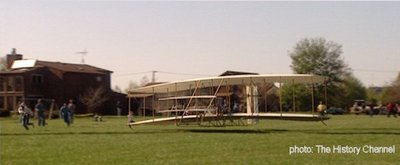
Events changed the original plans.
During the actual flight, the pilot has more control -- but no
fail-safe tethers. Those tethers are a mixed blessing. Ken told us
that in flight, "I limited my control -- you can't really move all
that much, on that plane. On the trailer earlier that morning, at
the end of the tow, we got a strong crosswind gust -- at that
point, I gave some angle of attack to the canard -- I just could
not get that plane down. It wasn't coming down. If I'd been in the
air, without that cabling, I would have stalled it. The plane just
lifted off, and kept on cranking up -- I was leaning forward, even
-- I couldn't get it down. That's when I broke the skid." That last
damage was what finally turned up the pressure to get the machine
into the air on its own.
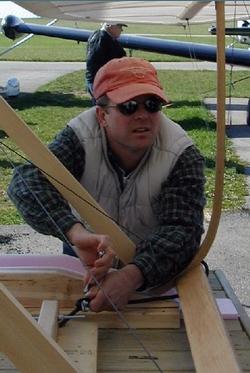 Sunday was supposed to have
been another tow-test day. "We didn't expect to fly," Kirincic
(right) reminded us. The Flyer had taken minor damage
on Saturday, and again on Sunday, in the tow tests. The team
wondered if maybe they should stop banging it up, and just try it.
"The fact that we flew at all was a result of our meeting. Flying,
believe it or not, is safer for the pilots than towing it. It's
better to hit grass than a trailer, another spotter, or
pavement."
Sunday was supposed to have
been another tow-test day. "We didn't expect to fly," Kirincic
(right) reminded us. The Flyer had taken minor damage
on Saturday, and again on Sunday, in the tow tests. The team
wondered if maybe they should stop banging it up, and just try it.
"The fact that we flew at all was a result of our meeting. Flying,
believe it or not, is safer for the pilots than towing it. It's
better to hit grass than a trailer, another spotter, or
pavement."
"I really wanted to go through the process of learning -- but
that towing incident got me thinking, 'somebody's going to
get hurt, and it's more than likely going to be me.'
That's when we decided to fly it off the rail."
Speaking of safety, we wondered what sort of safety equipment
the 155-pound (ready-to-fly weight) Kirincic employed. "I didn't
wear a helmet -- just my baseball cap, sunglasses -- and my safety
harness, that would keep me from getting ejected." Orville didn't
have the sunglasses, or the harness...
Slightly different conditions for flight; slightly different
landing runners...
Ken noted that the coefficient of friction of wood on grass
is different from that on dry sand, as the Wrights had at Kitty
Hawk.
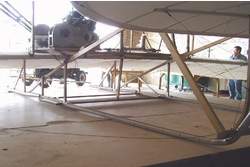 "In order to free up the
plane, we designed a plastic (PVC) rail system, right underneath
the rails, on the undercarriage. It really helped a lot -- once it
was on the lawn, it was more forgiving. We tried to simulate sand,
but we tried to better-match the friction coefficient --
wood against sand, vs plastic against lawn. We weren't
ready to wreck this airplane -- to replace the carriage every time
we flew it. We gave some thought about lining the rail with a
different system early on in the construction phase but in the last
minute Tilev "Turk" Turhan came up with what we have now -- it felt
a lot better."
"In order to free up the
plane, we designed a plastic (PVC) rail system, right underneath
the rails, on the undercarriage. It really helped a lot -- once it
was on the lawn, it was more forgiving. We tried to simulate sand,
but we tried to better-match the friction coefficient --
wood against sand, vs plastic against lawn. We weren't
ready to wreck this airplane -- to replace the carriage every time
we flew it. We gave some thought about lining the rail with a
different system early on in the construction phase but in the last
minute Tilev "Turk" Turhan came up with what we have now -- it felt
a lot better."
The extra drag the grass represented was a concern for the
Wright Redux team. Landing in sand would have been ideal, but
simulating the condition was the next-best alternative.
Clearly, stuffing the labor-intensive bird into the ground was not
part of the plan. Besides, they reasoned, the flight
experience would be closer-matched with that protective,
slipperier strip of PVC under the landing skids. "We have a lot of
engineers, who pretty much know coefficients -- wood against grass,
wood against sand, plastic against grass -- it was a pretty close
match," Ken noted.
Next flights should get green-lighted
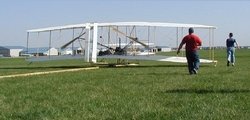 Actually flying was a huge
step, Ken told us. "From this first flight, this was a great
confidence-builder in the project. If we had continued with the
towing, we'd be a month behind." Ken trained with Mike Gillian and
with two Air Force pilots (Lt. Col. "Whip" and Major "Rocket," out
of WPAFB), at the Warren Dunes (MI) under the direction of Nick
Engler,of the Wright Aeroplane Company, who had given the team
great insight, with actual tow-flight demonstrations using his
1900, '01 and '02 gliders. Mr Kirincic explained: "We all thought
Mike would have been the first pilot; but Mike wasn't available
Sunday -- and, of course, nobody, even in the group, thought there
was going to be an actual flight that day..." Ken noted, "It's
unfortunate that Mike (seen below, being towed on the trailer)
couldn't have been there. He'll get his day, too." It wasn't
anything personal: "I'm sure Mike would have performed as well as I
did," Ken said. [Parallels are spooky: Orville got to be first
pilot on a coin toss...]
Actually flying was a huge
step, Ken told us. "From this first flight, this was a great
confidence-builder in the project. If we had continued with the
towing, we'd be a month behind." Ken trained with Mike Gillian and
with two Air Force pilots (Lt. Col. "Whip" and Major "Rocket," out
of WPAFB), at the Warren Dunes (MI) under the direction of Nick
Engler,of the Wright Aeroplane Company, who had given the team
great insight, with actual tow-flight demonstrations using his
1900, '01 and '02 gliders. Mr Kirincic explained: "We all thought
Mike would have been the first pilot; but Mike wasn't available
Sunday -- and, of course, nobody, even in the group, thought there
was going to be an actual flight that day..." Ken noted, "It's
unfortunate that Mike (seen below, being towed on the trailer)
couldn't have been there. He'll get his day, too." It wasn't
anything personal: "I'm sure Mike would have performed as well as I
did," Ken said. [Parallels are spooky: Orville got to be first
pilot on a coin toss...]
The replica engine, currently about a month away at builder
Packer Engineering, will be flown at the Museum of Science and
Industry; its TBO, estimated to be maybe 5 hours, precludes doing a
lot of "development" flying.
Flyer has a personality, and some quirks.
Ken filled us in on the Flyer's unique traits. "As far
as the plane is concerned, there are certainly certain things that
the plane likes," he explained. "There's definitely a [pitch-up]
limit, beyond which you can't recover. Pitch is sensitive," he
said; and to make flying it interesting, "it's pretty slow on roll
control." He learned a lot on the gliders: "In the gliding, we were
tethered; those tethers kept us in limits -- but, on the other
hand, we didn't know exactly what it would take to fly the plane,
control wise -- under free flight." The 1903 Flyer is not
forgiving: "There's a definite, small window in which this plane
has to be flown, You have to stay well-ahead of the game."
Advice for other 'Flyer' fliers:
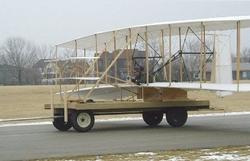 We asked Ken what he'd tell
other prospective Flyer pilots. He thought for a minute,
and said, "Just have fun with it. Know what you have to do, but
don't be too afraid to fly it. These planes are pretty rugged. The
more we fly these planes -- I have a much-greater respect for the
way the Wright brothers designed it. It's really one tough plane.
When you consider how long of a wingspan it has, and then look at
that landing gear..."
We asked Ken what he'd tell
other prospective Flyer pilots. He thought for a minute,
and said, "Just have fun with it. Know what you have to do, but
don't be too afraid to fly it. These planes are pretty rugged. The
more we fly these planes -- I have a much-greater respect for the
way the Wright brothers designed it. It's really one tough plane.
When you consider how long of a wingspan it has, and then look at
that landing gear..."
Wright Redux will be flying at the Museum of Science and
Industry in Chicago at the Air and Water Show, but Ken
hopes that the conditions on December 17 at Kitty Hawk are right,
for the planned flight of a different replica.
"The group shouldn't be pressured into trying to fly the
airplane when its conditions aren't just right. The right
wind, plus power, equals a good flying condition for that plane."
There may be embarrassing consequences, if the flight is attempted
in marginal conditions. "When we first started doing tow-testing,
it would do its crabbing thing right off the bat, but it would
drift off-course... I knew it would be a tough plane to fly. The
gliding tests reinforced that fact." Flying in a crosswind, or with
too little headwind, might not yield the desired results, he
opined. "The plane really needs wind to fly -- it really needs
wind, and the engine, to get it up." [The Wrights had about a 25
mph headwind. Wright Redux started with 15, which was, Ken thought,
barely enough. Sunday's subsequent flights, in reduced wind, were
barely off the ground --ed.]
Respect grew as experience accumulated.
 Kirincic's respect for the
Wrights has grown immensely, as he has gotten closer to their work.
"Their process was everything about being analytical -- nothing was
'willy-nilly' with them. I have great admiration for them."
Kirincic's respect for the
Wrights has grown immensely, as he has gotten closer to their work.
"Their process was everything about being analytical -- nothing was
'willy-nilly' with them. I have great admiration for them."
The dream's still there.
Ken still has that wonder about flight, that he remembers having
as a little kid, lying in his bed, imagining he was flying... "I
know a lot of kids that have dreams about flying," he remembered. I
still, to this day, have those dreams, but I never dreamt I'd fly a
Wright Flyer."
He's had the ultimate chance, flying while lying down and
everything. He's glad he did it. How does it feel to be the only
living person to have flown a 1903 Wright Flyer? Ken wasn't sure
that's what he is (there were some pretty-close replicas, he
reminded us); but he told us, "I'm really honored to be a part of
the Wright Redux program."
[Thanks to the Wright Redux folks, The History
Channel, and Chuck Clendinin for the photos --ed.]
 ANN's Daily Aero-Linx (04.16.24)
ANN's Daily Aero-Linx (04.16.24) Aero-News: Quote of the Day (04.16.24)
Aero-News: Quote of the Day (04.16.24) Airborne 04.10.24: SnF24!, A50 Heritage Reveal, HeliCycle!, Montaer MC-01
Airborne 04.10.24: SnF24!, A50 Heritage Reveal, HeliCycle!, Montaer MC-01 Airborne 04.12.24: SnF24!, G100UL Is Here, Holy Micro, Plane Tags
Airborne 04.12.24: SnF24!, G100UL Is Here, Holy Micro, Plane Tags Airborne-Flight Training 04.17.24: Feds Need Controllers, Spirit Delay, Redbird
Airborne-Flight Training 04.17.24: Feds Need Controllers, Spirit Delay, Redbird









